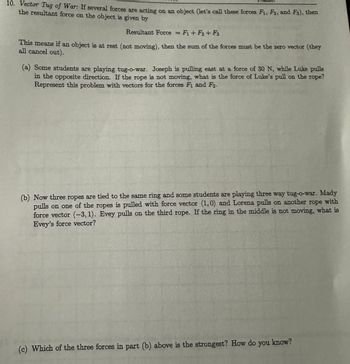
College Physics
11th Edition
ISBN: 9781305952300
Author: Raymond A. Serway, Chris Vuille
Publisher: Cengage Learning
expand_more
expand_more
format_list_bulleted
Question

Transcribed Image Text:10. Vector Tug of War: If several forces are acting on an object (let's call these forces F1, F2, and F3), then
the resultant force on the object is given by
Resultant Force = F₁+F2 + F3
This means if an object is at rest (not moving), then the sum of the forces must be the zero vector (they
all cancel out).
(a) Some students are playing tug-o-war. Joseph is pulling east at a force of 30 N, while Luke pulls
in the opposite direction. If the rope is not moving, what is the force of Luke's pull on the rope?
Represent this problem with vectors for the forces F₁ and F2.
(b) Now three ropes are tied to the same ring and some students are playing three way tug-o-war. Mady
pulls on one of the ropes is pulled with force vector (1, 0) and Lorena pulls on another rope with
force vector (-3,1). Evey pulls on the third rope. If the ring in the middle is not moving, what is
Evey's force vector?
(c) Which of the three forces in part (b) above is the strongest? How do you know?
SAVE
AI-Generated Solution
info
AI-generated content may present inaccurate or offensive content that does not represent bartleby’s views.
Unlock instant AI solutions
Tap the button
to generate a solution
to generate a solution
Click the button to generate
a solution
a solution
Knowledge Booster
Similar questions
- the rocket in a rocket powered airplane generates a steady force of 10,000 N in the foward direction and the plane moves horizontally at a constant velocity of 100 m/s through the air. The rocket engine is upgraded so that it now provides a foward force of 90,000 N. what is the new constant velocity of the plane> You cannot neglect air resistance in this question. 200 m/s 300m/s 400 m/s 600 m/s 900 m/sarrow_forwardd. Force is a vector quantity and thus has both a magnitude and a direction. A vector can be represented graphically by a line drawn to scale in the direction of the line of action of the force. To distinguish between vector and scalar quantities, various ways are used. Identify and explain threeof these ways.arrow_forwardAs shown in the figure, a woman is straining to lift a large crate, but without success because it is too heavy. We denote the forces on the crate as follows: P is the magnitude of the upward force being exerted on the crate by the person, C is the magnitude of the vertical contact force on the crate by the floor, and W is the weight of the crate. How are the magnitudes of these forces related while the person is trying unsuccessfully to lift the crate? OA P=C OB.P+C>W OCP+Carrow_forward
- An object of mass m is at rest on a smooth horizontal surface. It is pulled by a variable force F = kt, where t is the time. The force makes and angle a with the horizontal. a) find an expression for the speed of the object when it starts to lift-off the surface. b) find an expression for the distance travelled until it starts to lift-off the surface.arrow_forwardThree mass are arranged as shown. Mass A is 800 kg, Mass B is 400 kg, and Mass C is 600 kg. Draw a free body diagram for each mass. Find the net, vector force on each mass. A 8 m 90° В Mass A Mass B Mass C 12 marrow_forwardPart Barrow_forward
arrow_back_ios
arrow_forward_ios
Recommended textbooks for you
 College PhysicsPhysicsISBN:9781305952300Author:Raymond A. Serway, Chris VuillePublisher:Cengage Learning
College PhysicsPhysicsISBN:9781305952300Author:Raymond A. Serway, Chris VuillePublisher:Cengage Learning University Physics (14th Edition)PhysicsISBN:9780133969290Author:Hugh D. Young, Roger A. FreedmanPublisher:PEARSON
University Physics (14th Edition)PhysicsISBN:9780133969290Author:Hugh D. Young, Roger A. FreedmanPublisher:PEARSON Introduction To Quantum MechanicsPhysicsISBN:9781107189638Author:Griffiths, David J., Schroeter, Darrell F.Publisher:Cambridge University Press
Introduction To Quantum MechanicsPhysicsISBN:9781107189638Author:Griffiths, David J., Schroeter, Darrell F.Publisher:Cambridge University Press Physics for Scientists and EngineersPhysicsISBN:9781337553278Author:Raymond A. Serway, John W. JewettPublisher:Cengage Learning
Physics for Scientists and EngineersPhysicsISBN:9781337553278Author:Raymond A. Serway, John W. JewettPublisher:Cengage Learning Lecture- Tutorials for Introductory AstronomyPhysicsISBN:9780321820464Author:Edward E. Prather, Tim P. Slater, Jeff P. Adams, Gina BrissendenPublisher:Addison-Wesley
Lecture- Tutorials for Introductory AstronomyPhysicsISBN:9780321820464Author:Edward E. Prather, Tim P. Slater, Jeff P. Adams, Gina BrissendenPublisher:Addison-Wesley College Physics: A Strategic Approach (4th Editio...PhysicsISBN:9780134609034Author:Randall D. Knight (Professor Emeritus), Brian Jones, Stuart FieldPublisher:PEARSON
College Physics: A Strategic Approach (4th Editio...PhysicsISBN:9780134609034Author:Randall D. Knight (Professor Emeritus), Brian Jones, Stuart FieldPublisher:PEARSON

College Physics
Physics
ISBN:9781305952300
Author:Raymond A. Serway, Chris Vuille
Publisher:Cengage Learning

University Physics (14th Edition)
Physics
ISBN:9780133969290
Author:Hugh D. Young, Roger A. Freedman
Publisher:PEARSON

Introduction To Quantum Mechanics
Physics
ISBN:9781107189638
Author:Griffiths, David J., Schroeter, Darrell F.
Publisher:Cambridge University Press

Physics for Scientists and Engineers
Physics
ISBN:9781337553278
Author:Raymond A. Serway, John W. Jewett
Publisher:Cengage Learning

Lecture- Tutorials for Introductory Astronomy
Physics
ISBN:9780321820464
Author:Edward E. Prather, Tim P. Slater, Jeff P. Adams, Gina Brissenden
Publisher:Addison-Wesley

College Physics: A Strategic Approach (4th Editio...
Physics
ISBN:9780134609034
Author:Randall D. Knight (Professor Emeritus), Brian Jones, Stuart Field
Publisher:PEARSON